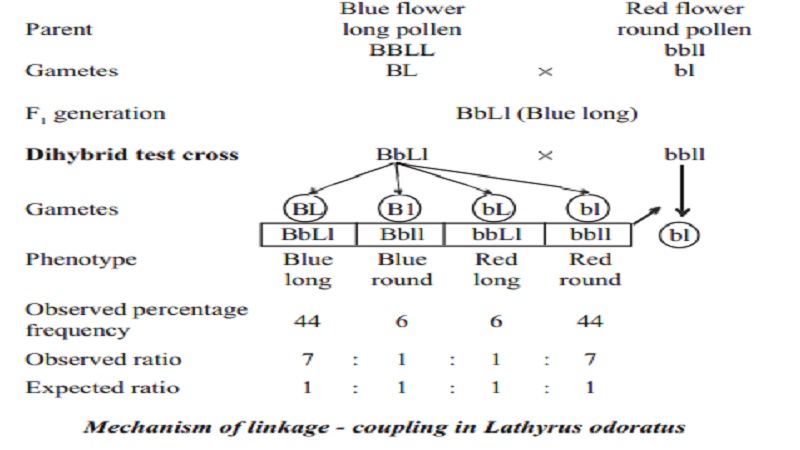Chapter: 11 th 12th std standard Bio Botany plant tree Biology Higher secondary school College Notes
Linkage and crossing over

Linkage and crossing over
The tendency of genes or characters to be inherited together because of their location on the same chromosome is called linkage. Many hybridization experiments were conducted both on plants and animals based on Mendel's work. The results of certain dihybrid crosses did not confirm the law of independent assortment. It states that the inheritance of genes of each pair in a dihybrid during gamete formation is independent of the other.

In 1906, William Bateson and Reginald Punnett conducted experiments in sweet pea, Lathyrus odoratus to confirm Mendel's dihybrid testcross. They observed an exception to the independent assortment of two genes in this plant. Here, blue flower (B) is dominant over the red flower (b) and long pollen (L) dominant over round pollen (l). They crossed true breeding plants having blue flower with long pollen (BBLL) and red flower with
round pollen (bbll). All the F1 hybrids have blue flowers with long pollen (BbLl). A testcross between heterozygous blue long (BbLl) of F1 hybrid and double recessive parental stock red round (bbll) did not result in ratio 1:1:1:1 but gave unexpected phenotype frequency as shown below.
Here, blue long and red round are parental forms and show greater frequency 88 per cent. Blue round and red long are recombinant forms and show lesser frequency 12 per cent. The dihybrid test cross ratio obtained is 7:1:1:7 and not 1:1:1:1. This indicates that the genes do not independently assort. From the above test cross, it is clear that if dominant alleles or recessive alleles are present in the same plant, they tend to remain together resulting in increased parental forms. Thus, the two genes which inherit together are called linked genes. This aspect is called coupling.

They made another cross between plants having blue flower with round pollen (BBll) and red flower with long pollen (bbLL). A testcross between
heterozygous blue long (BbLl) of F1 hybrid and double recessive red round (bbll) did not result in ratio 1:1:1:1 but gave unexpected phenotype frequency as shown below.
Here, blue round and red long are parental forms and show greater frequency 88 per cent. Blue long and red round are recombinant forms and show lesser frequency 12 per cent. The dihybrid test cross ratio obtained is 1:7:7:1 and not 1:1:1:1. This indicates that the genes do not independently assort. From the above testcross, it is clear that if dominant alleles or recessive alleles are present in the different plants, they tend to remain separate resulting in increased parental forms. This aspect is called repulsion.
Coupling and repulsion offered explanation for higher frequency of parental forms. They are two aspects of a single phenomenon called linkage. The genes that are carried on the same chromosome will not assort independently because of their tendency to remain linked together. This is called linkage. The genes located on the same chromosomes that are inherited together are known as linked genes. They tried to reconfirm the law of independent assortment. But they could not get expected result because the genes are linked.

Crossing Over
The process, which produces recombination of genes by interchanging the corresponding segments between nonsister chromatids of homologous chromosomes, is called crossing over. A crossing over between linked genes allows their recombination during meiosis.
Crossing over takes place in pachytene stage of prophase I of meiosis. In pachytene stage, the bivalent chromosome becomes tetrad i.e. with four chromatids. The adjacent nonsister chromatids are joined together at certain points called chiasmata. Crossing over occurs between the nonsister chromatids of paired chromosomes in the region of chiasma. At each chiasma, the two nonsister chromatids break, exchange their segments and rejoin resulting the crossing over.
Hence, out of four chromatids the two adjacent chromatids are recombinants and other two are original chromatids. Thus four types of gametes are obtained.
Significance of crossing over
1. Crossing over leads to the production of new combination of genes and provides basis for obtaining new varieties of plants.
2. It plays an important role in the process of evolution.
3. The crossing over frequency helps in the construction of genetic maps of the chromosomes.
4. It gives us the evidence for linear arrangement of linked genes in a chromosome.
Gene mapping
Genes are arranged linearly in a chromosome. The point in a chromosome where the gene is located is called locus. The diagrammatic representation of location and arrangement of genes and relative distance between linked genes of a chromosome is called linkage or genetic map.
The unit of genetic map is Morgan or centimorgan. When the percentage of crossing over between two linked genes is 1 per cent, then the map distance between the linked genes is one morgan.
There is a greater probability of occurrence of crossing over, when the two genes are farther apart in a chromatid. The probability of crossing over between two genes is directly proportional to the distance between them.
When two genes are nearer, the probability of occurrence of crossing over between them is limited.
Let A, B, C, D and E be five knots on a string separated by the distances as shown. The probability of making a random cut between two knots is directly proportional to the distance between them. Every cut separates A from E, whereas 5/100th cut only separates C from D.If the knots or genes linearly arranged on a chromosome in randoms are the cross overs, then C and D remain linked, whereas A and E will not show linkage in this situation.
Uses of gene mapping
1. It is useful to determine the location, arrangement and linkage of genes in a chromosome.
2. It is useful to predict the results of dihybrid and trihybrid crosses.
Related Topics